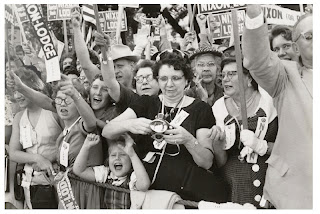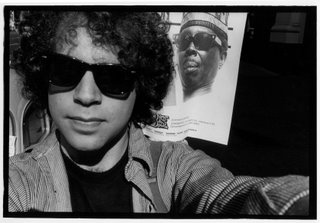This is the perfect time of year for a Cartier-Bresson exhibition. The streets of New York are alive in spring and summer. For Henri Cartier-Bresson all streets everywhere were alive, and his eyes were always open, his fingers on the shutter always ready to capture what his eyes might see. There really is no collection of photographs like this - where one stands in front of every picture wondering "how did he get that?"
I can remember being introduced to the work of Cartier-Bresson around 1972, looking at the catalog for a 1968 exhibition at this very same MOMA. I spent hours with that book, I spent a whole weekend with that book, and I spent a year or two with that book. Looking through page after page, at the incomprehensible beauty of how a camera can translate life into art. I might as well have been a little kid gaping at a magician. I was literally shaken to the core.
This is an enormous show. Too enormous to take in with only one viewing. Perhaps you want to start with the tremendously engaging online version of the exhibition on MOMA's website here:
Online, you can view and read about the photos in the comfort of your own home. This will prepare you for being in a room with the actual artifacts - the prints made from the negative that was in the camera that was in the photographers hand, out there in the real world.
How do you comprehend how someone could conceive of taking the picture above - made in Cordoba, Spain in 1933? I don't know, but I offer what John Szarkowski wrote about it in his essential MOMA book "Looking At Photographs" "This photograph concerns gesture, line, shape, scale, the flatness of the picture plane, and the difference between art and life. To say that the picture concerns these things does not, of course, mean that it explains them."
All the monumental shots are here. The exhibition starts with an informative introduction to the various printing styles you'll see in the exhibition. But from there you're on your own, moving from room to room and various locations around the globe. The pleasure is in discovering the rare finds among the gems.
I had never seen this picture taken in Mexico in 1963. This is one you really have to see in the gallery to appreciate - like viewing a movie in a theater instead of on your television screen. I stood starting at this one for about ten minutes, and it called out to me every time I passed through the room. You won't see everything on your first visit, but you will find your own new favorites - I guarantee that.
Like this one from Shanghai in 1949. Startling. Wong Kar-wai anyone?
Here are a few from his journeys across America in the 50's and 60's.
I must say that the layout of the exhibition is it's only drawback. The layout is a little too carefully arrayed for my taste. The organization by themes tends to inhibit the pleasure of appreciating individual photographs, if you let it. Don't let it. Just keep your mind on each and every picture, much like they were taken - one by one. Here is a quote from the master himself. It's from the introduction to that same 1968 Cartier-Bresson MOMA catalog:
"Sometimes one remains motionless, waiting for something to happen; sometimes the situation is resolved and there is nothing to photograph. If something should happen, you remain alert, wait a bit, then shoot and go off with the sensation of having got something. Later you can amuse yourself by tracing out on the photo the geometrical pattern, or spatial relationships, realizing that, by releasing the shutter at that precise instant, you had instinctively selected an exact geometrical harmony, and that without this the photographs would have been lifeless. But to apply a golden rule, a photographer's compass can be nowhere but in his eye." - Henri Cartier-Bresson
I suggest that you hold on to this advice while walking through the MOMA galleries. But however you go there - virtually or digitally - be there now. And be prepared, for when you exit the museum, and step out onto the New York streets, everything will look like a Cartier-Bresson picture. You might want to carry your camera and your "photographer's compass". Oh, and btw Friday evenings at MOMA are free.


















No comments:
Post a Comment